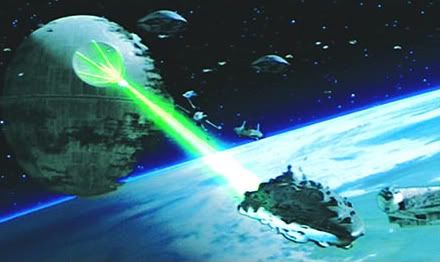Post by Rose on Apr 24, 2007 18:24:19 GMT -5
Superlaser


Basic Information -
Manufacturer: Various Contractors
Type: Planet-Destroying Superweapon
Affiliation: Empire
Associations: Death Star; Death Star II; Imperial Gunners
The Death Star's prime weapon unleashed unthinkable levels of raw energy capable of tearing apart entire worlds. That energy began deep inside the gargantuan station, and was eventually channeled into an array of eight tributary laser cannons. The beams from these cannons culminated into a central blast directed from the eye-shaped concavity in the Death Star's upper hemisphere. Teams of highly skilled Imperial gunners manned advanced control stations, managing the titanic weapon. With this weapon, the Death Star reduced Alderaan to rubble. It never had a chance to fire again, as the Rebel Alliance was able to destroy the station at the Battle of Yavin. It wasn't long before the weapon was resurrected in an improved form aboard the second Death Star. This second cannon could target capital ships and its power yields could be managed to support frequent firing. Many key Alliance warships were vaporized by the Death Star during the Battle of Endor.
The Death Star's superlaser was a triumph of combat engineering. Though the concept of culminating laser beam amplification had existed in the latter days of the Republic, the sheer scale of the Death Star's prime weapon is staggering. For optimum performance, the superlaser was manned by 168 Imperial gunners, with at least 14 soldiers manning each of the initiator lasers. The majority of the Death Star's interior volume was dedicated to housing and supporting the superlaser. The weapon's heart drew power directly from the station's raging hypermatter core, converting and amplifying the colossal powers into focussed energy. The eight tributary laser beams converged at a central amplification nexus. The outer perimeter of the superlaser dish also had four back up lasers should any of the eight fail. The lens of the cannon (colloquially known as "the Eye") was built around an immense amplification crystal .
The superlaser's power needed recharging between blasts, limiting the number of firings per day. The weapon could produce a blast scaled to destroy capital ships at a rate of one per minute. The superlaser could only fire planet-destroying yields once per day. With the amount of research and resources allocated to the superlaser project, it's little wonder this weapon was not allowed to die with the destruction of the Death Star. As refinements in the technology were carried out aboard the Tarkin weapons platform, the second Death Star was developed. Though the second never saw completion, its operational superlaser performed commendably during the Battle of Endor. Even after the Battle of Endor, the threat of superlaser technology returned to haunt the New Republic. The original and functional concept model of the Death Star emerged from Maw Installation, but was quickly defeated. A new but ultimately ill-fated generation of Eclipse- and Sovereign-class Star Destroyers featured axial superlasers that, while not able to obliterate a planet, could sear a planet's entire surface. Even the ambitious Hutts launched a woe-filled caper to secure a superlaser with the development of their disastrous Darksaber project.
